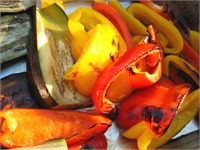
How to Grill Vegetables
Important Notice: Our web hosting provider recently started charging us for additional visits, which was unexpected. In response, we're seeking donations. Depending on the situation, we may explore different monetization options for our Community and Expert Contributors. It's crucial to provide more returns for their expertise and offer more Expert Validated Answers or AI Validated Answers. Learn more about our hosting issue here.

How to Grill Vegetables
You must be logged in to post a comment.
Grilling vegetables is an art form that is easy to master, but also easy to mess up. There are two ways you can grill your vegetables: on a barbecue (charcoal or propane) or on an indoor grill that looks like a skillet. You can choose either way depending on the season. However, grilling outside gives the vegetables that fire-roasted flavor and look that is impossible to duplicate through any other cooking method.
How to Prepare Your Vegetables for the Grill
When selecting vegetables you want to choose firm vegetables that won’t fall apart or through the grill into the flames. This means that you probably should not try to grill peas, broccoli florets (the long stemmed broccoli is good though), cauliflower, radishes, etc.
It’s controversial, but some people like to even grill their Romaine lettuce before assembling a salad. This is okay if you have a hot enough grill with a big char, but if your lettuce gets too steamy it can get soggy and wilted which is not good at all.
There are a handful of fool proof vegetables you can always stick to: asparagus, tomatoes, bell peppers, onions, eggplant, zucchini, and potatoes. These veggies are long enough that they won’t fall through the grill and sturdy enough that they won’t fall through.
Cut your vegetables in considerably large pieces. The beauty of grilled vegetables is that they never come out the same way twice. Some bits char, and some will become tender. Grilling brings out the natural sweetness of the vegetables, but if they’re cut too small they will burn and turn bitter.
Dressing Your Vegetables
Keep it simple and don’t put anything on your vegetables that can burn and turn bitter like garlic powder, cayenne pepper, or red pepper flakes. Stick to the basics: kosher salt, freshly ground pepper, and vegetable oil (extra virgin olive oil and butter have a lower smoking temperature and can tend to burn more quickly or catch on fire). On a cookie sheet, spread out all of your vegetables and drizzle with vegetable oil. Sprinkle liberally with salt and pepper so it will make a nice crust.
Grilling Your Vegetables
Take your prepared veggies on your cookie sheet out to a hot grill. Brush the grates with some olive oil to keep your veggies from sticking.
With a pair of tongs place the veggies perpendicular to the barbecue grates for great grill lines. You’ll know when to rotate your vegetables when they start to char and become tender. Make sure not to overcook them or else you will have burnt carbon instead of nutritious vegetables. It’s better to undercook rather than overcook.